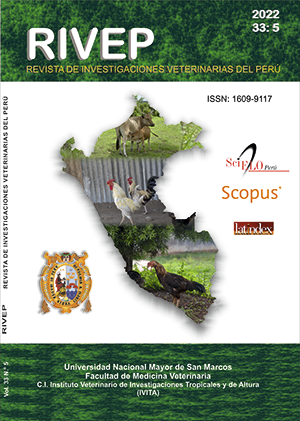Morphometric assessment of a population of Araucanian creole pigs (Colombia)
DOI:
https://doi.org/10.15381/rivep.v33i5.23794Keywords:
adaptability, sexual dimorphism, animal structure, body measurementsAbstract
The morphometry is a tool to quantify and analyze morphological variation in the size and shape of animals. The aim of this study was to contribute to the morphometric characterization of the Araucanian creole pig to know some of its functional and ethnological characteristics. For this. 58 pigs (27 females and 31 males), aged between 4 and 48 months, located in three villages of Arauca, eastern Colombia, were studied. Eleven individual body measurements were obtained, and three indices were constructed. Descriptive statistics and univariate analysis were applied to measure the environmental effect on body measurements and indices, using age as a covariate. The pigs showed a medium variability in body measurements associated with a medium harmony. These animals are considered to be dolichocephalic, mesolineal and not suitable for meat purposes. The females tended to be larger than the males. The village was the only effect that influenced the linear combination of the morphological variables and indices. Given the variability of the measurements according to the villages, it could be inferred that different biotypes are present in the Araucanian pigs studied.
Downloads
Downloads
Published
Issue
Section
License
Copyright (c) 2022 Arcesio Salamanca-Carreño, Pere Miquel Parés-Casanova, Oscar Mauricio Vélez Terranova, Gustavo Castro Rosa, Raúl Jáuregui

This work is licensed under a Creative Commons Attribution 4.0 International License.
AUTHORS RETAIN THEIR RIGHTS:
a. Authors retain their trade mark rights and patent, and also on any process or procedure described in the article.
b. Authors retain their right to share, copy, distribute, perform and publicly communicate their article (eg, to place their article in an institutional repository or publish it in a book), with an acknowledgment of its initial publication in the Revista de Investigaciones Veterinarias del Perú (RIVEP).
c. Authors retain theirs right to make a subsequent publication of their work, to use the article or any part thereof (eg a compilation of his papers, lecture notes, thesis, or a book), always indicating the source of publication (the originator of the work, journal, volume, number and date).










